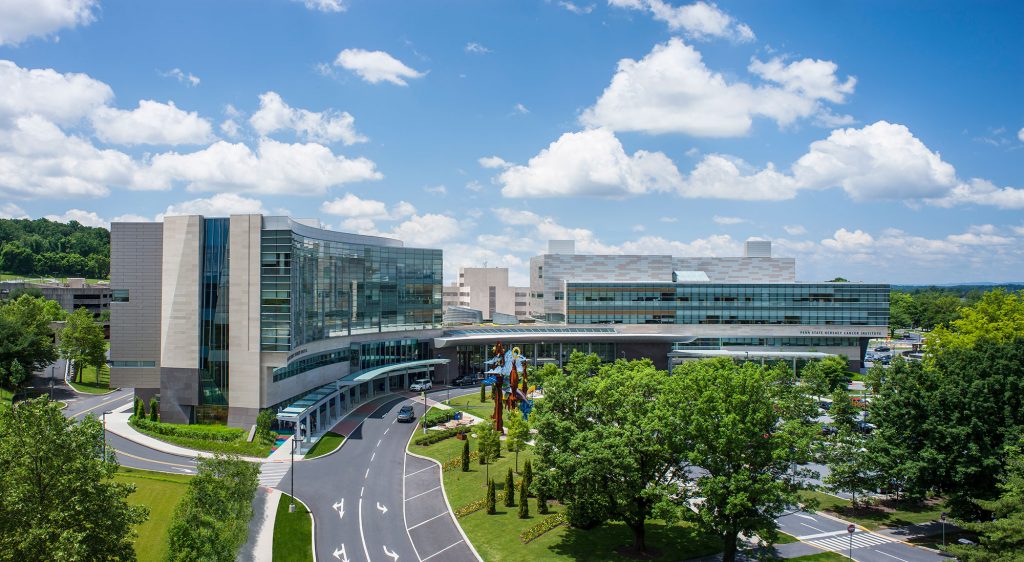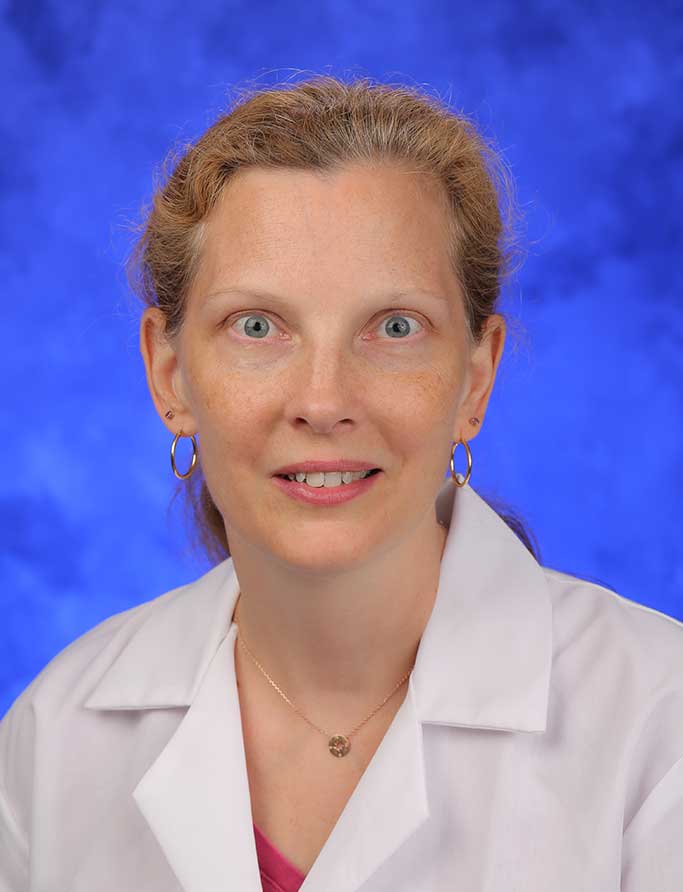Jump to topic
Search
Program Details
The Vascular Neurology (Stroke) Fellowship offers postgraduate training in advanced neurology with specific focus on stroke and cerebrovascular disease. Fellows will train under the guidance of board-certified clinical neurologists with subspecialty training in vascular neurology. Fellows have the opportunity to do clinical stroke research and community outreach.
Comprehensive exposure to all aspects of cerebrovascular disease, including ischemic and hemorrhagic stroke, vascular dementia, prevention and acute stroke treatment, stroke genetics and stroke-related imaging, through outpatient and inpatient clinical rotations is the focus of the fellowship. Penn State Health Milton S. Hershey Medical Center serves as a major stroke center to a large underserved population of more than 2 million patients in central Pennsylvania and is the only tertiary referral center for patients with cerebrovascular diseases in the region. As such, the department manages a wide variety of patients with cerebrovascular disease.
The program offers active participation in clinical and translational research, teaching and community outreach. The fellow will have the opportunity to become actively involved in the area of clinical cerebrovascular research and can choose from a wide variety of ongoing clinical trials in stroke prevention, imaging and acute stroke treatment. The department has many close relationships and collaborations within the institution, with universities in Pennsylvania and throughout the nation, allowing a broad involvement in scholarly activities.
The program allows fellows to be trained in neuroultrasound, stroke-related neuroimaging and neurocritical care. All fellows will participate in multidisciplinary stroke management and cutting-edge acute stroke interventions. Fellows can become involved in community outreach programs and in epidemiology-based stroke research. Fellows will be asked to teach. Teaching responsibilities will involve medical students, residents, CME courses for practicing doctors and patient/lay audiences.
Fellows are expected to provide on-call coverage from home and to be available via pager at assigned periods of time. Such on-call time will not exceed more than six months in each 12-month period of training. All cases will be discussed with the stroke attending, who is available 24 hours a day, seven days a week, but will allow the fellow to become increasingly independent in the management of stroke patients.
Fellows are eligible for four weeks of paid vacation time and four days of educational meeting time to present their poster or oral presentation.
Learn More about the Fellowship
General Application Information
Applications for the Vascular Neurology Fellowship are accepted through the Electronic Residency Application Service (ERAS).
Application Requirements
Before starting a fellowship, the candidate will have successfully completed an ACGME-approved residency program in neurology. The candidate must be board-eligible or board-certified in neurology.
In addition, applicants must be one of the following:
- A U.S. citizen
- A permanent resident (green card holder)
- The holder of a J-1 visa sponsored through ECFMG
The organization does not sponsor any other visas.
Virtual Tour
Penn State Health
Penn State Health is an integrated academic health system serving patients and communities across 15 counties in central Pennsylvania. It employs more than 20,900 people systemwide.
The system includes Penn State Health Milton S. Hershey Medical Center, Penn State Health Children’s Hospital and Penn State Cancer Institute based in Hershey, Pa.; Penn State Health Hampden Medical Center in Enola, Pa.; Penn State Health Holy Spirit Medical Center in Camp Hill, Pa.; Penn State Health Lancaster Medical Center in Lancaster, Pa.; Penn State Health St. Joseph Medical Center in Reading, Pa.; Pennsylvania Psychiatric Institute, a specialty provider of inpatient and outpatient behavioral health services, in Harrisburg, Pa.; and 2,417 physicians and direct care providers at 225 outpatient practices. Additionally, the system jointly operates various healthcare providers, including Penn State Health Rehabilitation Hospital, Hershey Outpatient Surgery Center and Hershey Endoscopy Center.
In 2017, Penn State Health partnered with Highmark Health to facilitate creation of a value-based, community care network in the region.
Penn State Health shares an integrated strategic plan and operations with Penn State College of Medicine, the University’s medical school. With campuses in State College and Hershey, Pa., the College of Medicine boasts a portfolio of more than $150 million in funded research and more than 1,700 students and trainees in medicine, nursing, other health professions and biomedical research.
Learn more about Penn State Health

Penn State Health Children’s Hospital (left), Penn State Health Milton S. Hershey Medical Center (center) and Penn State Cancer Institute (right)
Penn State Health Milton S. Hershey Medical Center
500 University Dr., Hershey, Pa., 17033 (Derry Township, Dauphin County)
- The health system’s 611-bed flagship teaching and research hospital
- The only medical facility in Pennsylvania accredited as both an adult and a pediatric Level I (highest-level) trauma center
- Dedicated surgical, neuroscience, cardiovascular, trauma and medical intensive care units
- Accredited Life Lion critical-care transport providing more than 1,100 helicopter and approximately 750 ground ambulance transports per year
- More than 1,300 faculty members and more than 650 residents and fellows
- Approximately 29,000 admissions, 73,000 emergency department visits, 1.1 million outpatient visits and 33,000 surgical procedures annually
- Designated as a Magnet hospital since 2007
Learn more about Milton S. Hershey Medical Center
Penn State Health Children’s Hospital
600 University Dr., Hershey, Pa. 17033 (Derry Township, Dauphin County)
- An eight-story, 263,000-square-foot-facility built in 2013 and expanded in 2020
- 160 licensed pediatric beds, 26-bed pediatric intensive care unit and a 56-bed neonatal intensive care unit
- Level IV (highest-level) neonatal intensive care unit
- Level I quaternary (highest-level) pediatric intensive care unit
- Level I (highest-level) pediatric trauma center designation
- Intermediate care unit
- Dedicated pediatric operating rooms
- More than 150,000 pediatric outpatient visits, 20,000 pediatric emergency room visits, and approximately 5,000 pediatric patient discharges annually
Welcome to Hershey
More About Hershey
Interested in learning more about living and working in Hershey, Pa.? See details here:
Wellness, including emotional, spiritual, social and physical health, is a crucial component to training and to becoming a professional, compassionate and resilient physician. Self-care is a skill which must be continually practiced and reinforced. Penn State College of Medicine and Penn State Health are committed to addressing wellness among residents and fellows, with multiple resources readily available.
Institutional resources
- Visit BeWell – a health program designed to support Penn State Health employees
- See Penn State College of Medicine wellness resources here
- Employee Health Care Concierge and Case Management Service
- Partners in Medicine
Moving to a new city with your family does not have to be stressful. Residency programs have assisted many significant others with finding employment. There is also a GME-Wide Partners in Medicine (PIM) group that offers networking opportunities as well as various social and community oriented activities. - The Doctors Kienle Center for Humanistic Medicine
- Active and easily accessed Office of Professional Mental Health
Graduate medical education resources
Institutional Resources
Penn State Health and Penn State College of Medicine celebrate, embrace and support the diversity of all patients, faculty, staff, students and trainees.
Office for Diversity, Equity and Inclusion
In keeping with this, Penn State Health has an active Office for Diversity, Equity and Inclusion with various programs, networks and resource groups, including:
- Talks and lectures on diversity, equity and inclusion through the Inclusion Academy
- Regular events on topics such as eradicating racism and creating a culture of inclusiveness
- Many Business Employee Resource Groups (BERGs), including:
- Disability Business Employee Resource Group
- Interfaith Business Employee Resource Group
- LGBTQ+ Business Employee Resource Group
- Military and Veterans Business Employee Resource Group
- Multicultural Business Employee Resource Group
- NextGen Business Employee Resource Group
- Black Physician Professional Staff Association – Resource Group
- Hispanic Professional Association
- Asian Physician and Professional Staff Association
- International Workforce Inclusion
- Inclusion Academy
Learn more about the Penn State Health Office for Diversity, Equity and Inclusion
Learn more about the College of Medicine’s Office for Diversity, Equity and Belonging
Office for Culturally Responsive Health Care Education
The vision at Penn State College of Medicine and Penn State Health is to equip learners with the knowledge, skills and attitudes they will need to provide culturally excellent health care and research for an increasingly diverse U.S. population. The Office for Culturally Responsive Health Care Education was formed to help meet that goal.
Learn more about the Office for Culturally Responsive Health Care Education
Office for a Respectful Learning Environment
In addition, the institution does not tolerate discrimination, biases, microaggression, harassment or learner mistreatment of any kind, and any concerns are immediately addressed by the Office for a Respectful Learning Environment.
Learn more about the Office for a Respectful Learning Environment
Network of Under-represented Residents and Fellows
The Network of Under-represented Residents and Fellows (NURF) is a group of diverse residents and fellows representing all specialties. NURF’s goal is to promote cultural diversity in the residency programs through community involvement, mentorship with diverse faculty, professional networking and support for the recruitment of diverse medical students into the residency programs.
NURF is sponsored by the Penn State College of Medicine Graduate Medical Education Office and the Penn State Health Office for Diversity, Equity and Inclusion.
Mailing Address
Penn State Health Milton S. Hershey Medical Center
Department of Neurology, H037
30 Hope Dr.
Hershey, PA 17033
General Contact Information
Fax: 717-531-0384
Latest News from Neurology





